*NURSING > QUESTIONS & ANSWERS > NURS 6512 Advanced Health Assessment Week 7 Quiz. Score 100% (All)
NURS 6512 Advanced Health Assessment Week 7 Quiz. Score 100%
Document Content and Description Below
NURS 6512 Week 7 Quiz. Questions & Answers Question 1 Inspection of the abdomen should begin with the patient supine and the examiner: Selected Answer: seated on the patient s... right side. Correct Answer: seated on the patient s right side. Response Feedback: This preferred initial position allows tangential viewing of the abdomen for improved assessment of abdominal contour. • Question 2 2 out of 2 points In older adults, overflow fecal incontinence is commonly due to: Selected Answer: fecal impaction. Correct Answer: fecal impaction. Response Feedback: Constipation with overflow occurs when the rectum contains hard stool and soft feces above leak around the mass of stool. • Question 3 2 out of 2 points Which organ(s) are located in the retroperitoneal space? Selected Answer: Kidneys Correct Answer: Kidneys Response Feedback: The kidneys are located in the retroperitoneal space, lying behind the abdominal cavity and beside the abdominal aorta. • Question 4 2 out of 2 points In order to correctly document absent bowel sounds, one must listen continuously for: Selected Answer: 5 minutes. Correct Answer: 5 minutes. Response Feedback: Absent bowel sounds are confirmed after listening to each quadrant for 5 minutes. • Question 5 2 out of 2 points When palpating the aorta, a prominent lateral pulsation suggests: Selected Answer: aortic aneurysm. Correct Answer: aortic aneurysm. Response Feedback: Anterior pulsations of the aorta are within normal limits; lateral pulsations suggest an aortic aneurysm. • Question 6 2 out of 2 points Patients presenting with ascites, jaundice, cutaneous spider veins, and nonpalpable liver exhibit signs of: Selected Answer: cirrhosis. Correct Answer: cirrhosis. Response Feedback: Icterus is a result of excessive bilirubin that can result from cholecystitis, pancreatitis, or liver problems. Cirrhosis presents with additional symptoms of ascites, cutaneous spider veins, and a nonpalpable liver as scarring progresses. • Question 7 2 out of 2 points The major function of the large intestine is: Selected Answer: water absorption. Correct Answer: water absorption. Response Feedback: The major function of the large intestine is the absorption of water and excretion of solid waste material in the form of stool. Mucous glands secrete large quantities of alkaline mucus. • Question 8 2 out of 2 points Percussion at the right midclavicular line, below the umbilicus, and continuing upward is the correct technique for locating the: Selected Answer: lower liver border. Correct Answer: lower liver border. Response Feedback: Percussing along the right midclavicular line upward from the umbilicus determines the lower border of the liver. A liver border more than 2 to 3 cm signifies hepatomegaly. • Question 9 0 out of 2 points Infants born weighing less than 1500 g are at higher risk for: Selected Answer: [None Given] Correct Answer: necrotizing enterocolitis. • Question 10 2 out of 2 points Costovertebral angle tenderness should be assessed whenever you suspect the patient may have: Selected Answer: pyelonephritis. Correct Answer: pyelonephritis. Response Feedback: Pyelonephritis is characterized by flank pain and costovertebral angle tenderness. • Question 11 2 out of 2 points After thorough inspection of the abdomen, the next assessment step is to: Selected Answer: auscultate. Correct Answer: auscultate. Response Feedback: Assessment of the abdomen begins with inspection followed by auscultation. This break from the usual system examination sequence is because palpation and percussion can alter the frequency as well as the intensity of bowel sounds. Therefore, auscultation is done first. • Question 12 2 out of 2 points A 23-year-old man comes to the urgent care clinic with intense left flank and lower left quadrant pain. One patient response to history of present illness questions that further supports a tentative diagnosis of renal calculi is: Selected Answer: My left testicle and shoulder hurt as well. Correct Answer: My left testicle and shoulder hurt as well. Response Feedback: Renal calculi present with hematuria, intermittent flank pain that radiates to the groin and genitals, and a positive Kehr sign (pain radiating to the left shoulder). • Question 13 2 out of 2 points A patient presents to the emergency department after a motor vehicle accident. The patient sustained blunt trauma to the abdomen and complains of pain in the upper left quadrant that radiates to the left shoulder. What organ is most likely injured? Selected Answer: Spleen Correct Answer: Spleen Response Feedback: Spleen laceration/rupture is always suspected with abdominal injury, because of its anatomic location. The patient s presenting symptoms confirm this suspicion. • Question 14 2 out of 2 points Before performing an abdominal examination, the examiner should: Selected Answer: have the patient empty his or her bladder. Correct Answer: have the patient empty his or her bladder. Response Feedback: The patient should empty the bladder to ensure an accurate examination of organs as well as to provide comfort for the patient. • Question 15 0 out of 2 points Your trauma patient has no auscultated breath sounds in the right lung field. You can hear adequate sounds in the left side. A likely cause of this abnormality could be that the patient: Selected Answer: has minimal fluid in the pleural space. Correct Answer: has a pneumothorax. • Question 16 2 out of 2 points Clear or amber drainage from the nose or ears of a blunt trauma patient may indicate: Selected Answer: basilar skull fracture. Correct Answer: basilar skull fracture. Response Feedback: Clear or amber drainage from the nose or ears may indicate a basilar skull fracture. Epiglottitis and retropharyngeal abscess will result in airway obstruction while aspiration will result in hypoxemia. A perforated tympanic membrane will have a bloody drainage. • Question 17 2 out of 2 points Mr. Green is a 68-year-old patient who has complained of pain. As the health care provider, you have decided to use a pain scale for documentation of the patient's pain. The value of the use of scales for patients to rate their pain intensity is that: Selected Answer: C. the patient’s response to therapy can be documented. Correct Answer: C. the patient’s response to therapy can be documented. Response Feedback: The use of scales permits the very important day-to-day documentation of the response to therapy. Although the patient's perception is the controlling variable, the patient is still giving a subjective measurable response. Emotional responses are not factored into a pain scale. The patient's rating is the gold standard for that patient; it does not correlate with others' expectations. The patient's response is subjective data on pain for that patient. • Question 18 2 out of 2 points The Joint Commission (TJC, formerly The Joint Commission on Accreditation of Healthcare Organizations [JCAHO]) requires that: Selected Answer: C. repeated intensity documentation be made of the course of pain relief for all patients. Correct Answer: C. repeated intensity documentation be made of the course of pain relief for all patients. Response Feedback: TJC requires pain assessment on all admissions, repeated assessments for pain regardless of an initial complaint or surgical experience, and repeated intensity documentation of the course of pain relief for all patients. • Question 19 2 out of 2 points You are caring for a patient with trigeminal neuralgia. During the assessment, the patient would describe the pain as: Selected Answer: B. burning or shocklike. Correct Answer: B. burning or shocklike. Response Feedback: Pain resulting from nerve tissue damage is described as having a burning, shock-like (electrical) quality. Throbbing and dull pain is usually due to a tumor pressing on a cavity. Tender and deep pain results from bone or soft tissue. Cramping and spasmodic pain is usually visceral or colic pain. • Question 20 0 out of 2 points Your 85-year-old patient is complaining of right knee pain. She has a history of osteoarthritis for which she is given antiinflammatory medication. To assess her right knee pain, you should ask her if: Selected Answer: D. the pain gets better when she sits. Correct Answer: C. she took pain medication last night. Response Feedback: It is most appropriate to ask a present tense evaluation question, such as whether the patient took her pain medication; the question should be simply worded without the addition of multiple factors to consider. You should refrain from asking older patients to compare past with present symptoms, because recollection may be uncertain and recollection of past pain is sometimes not readily achieved. Systematic evaluation of the right knee should be completed before any additional symptoms are evaluated. Knowing that the pain gets better when she sits does not help assess the right knee pain. [Show More]
Last updated: 8 months ago
Preview 1 out of 6 pages

Reviews( 0 )
Document information
Connected school, study & course
About the document
Uploaded On
Aug 30, 2019
Number of pages
6
Written in
Additional information
This document has been written for:
Uploaded
Aug 30, 2019
Downloads
0
Views
127





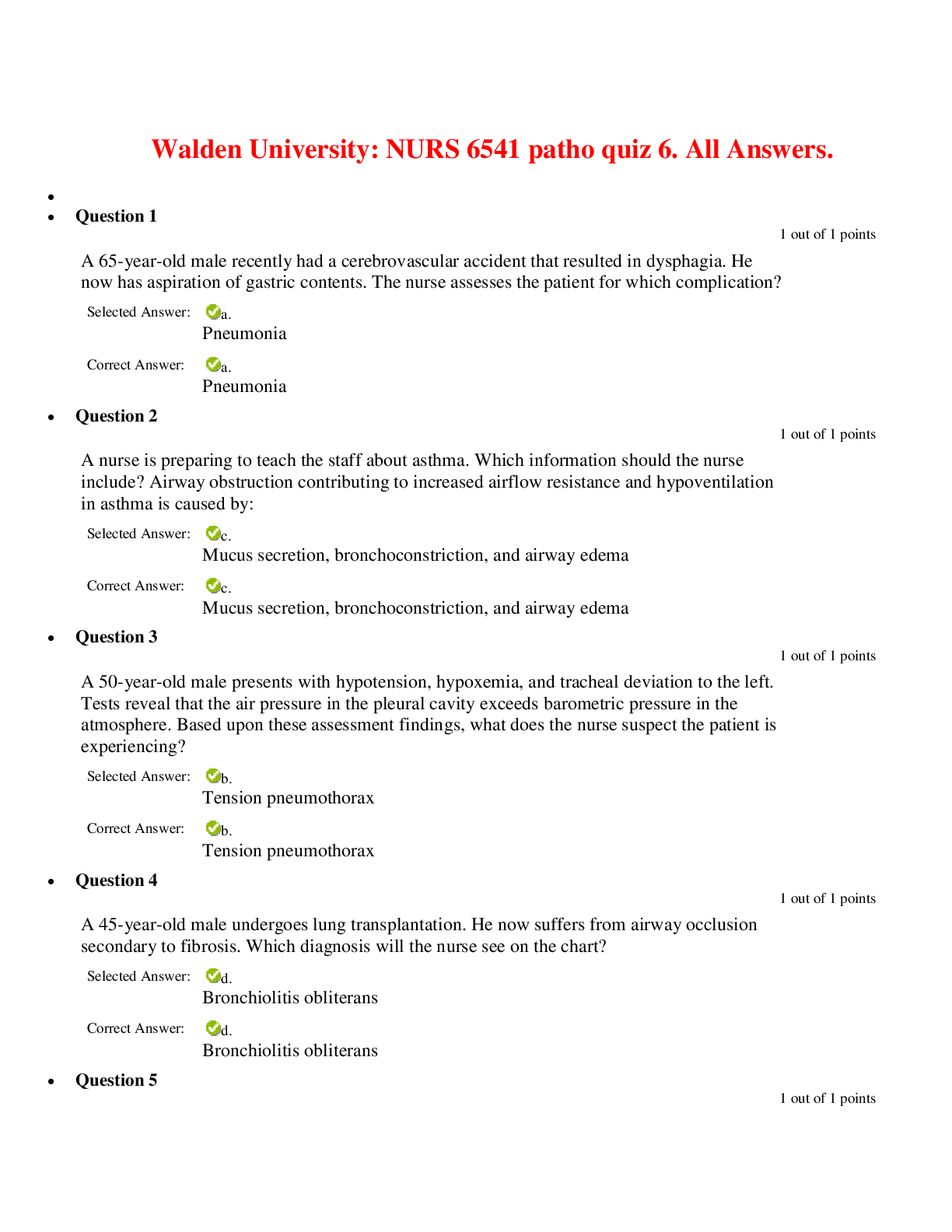




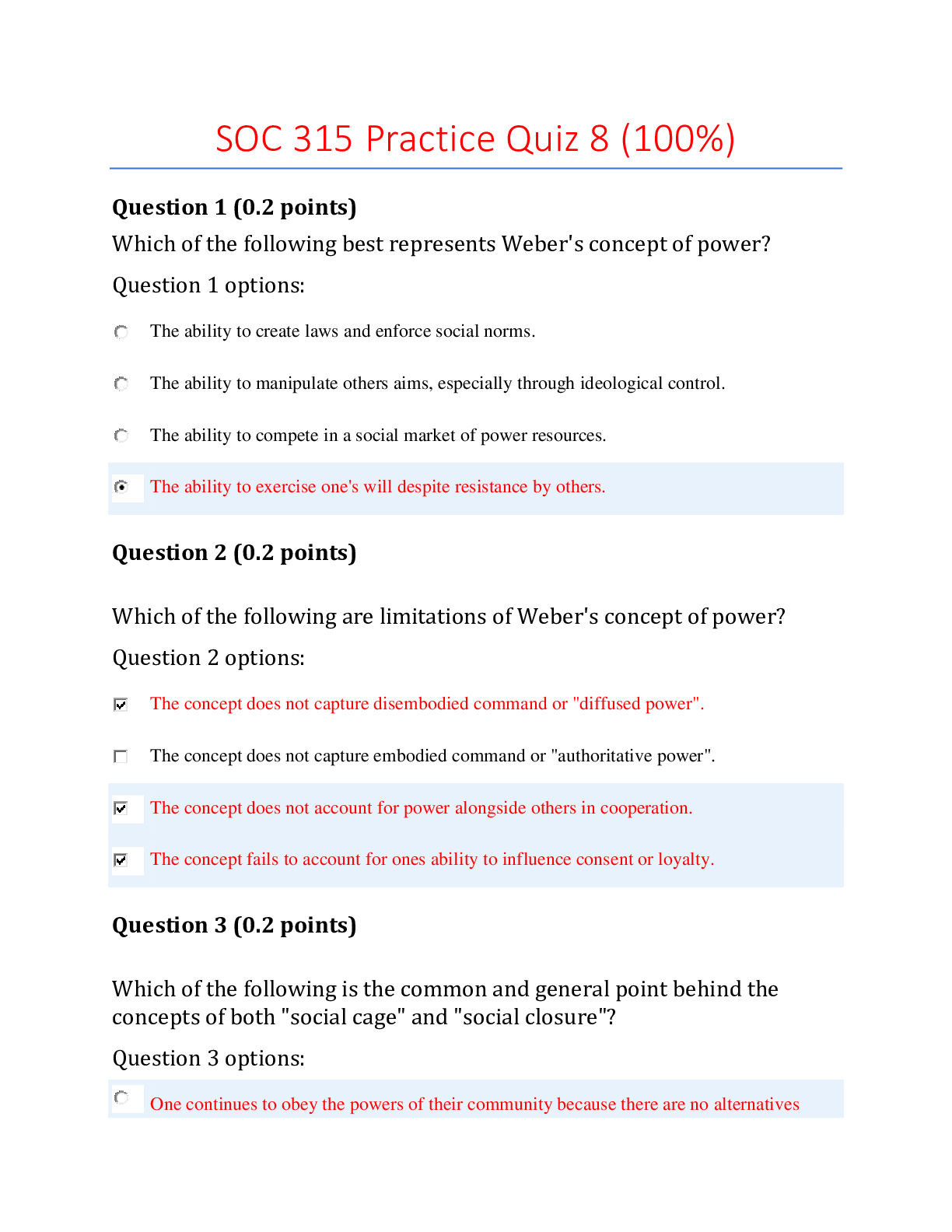
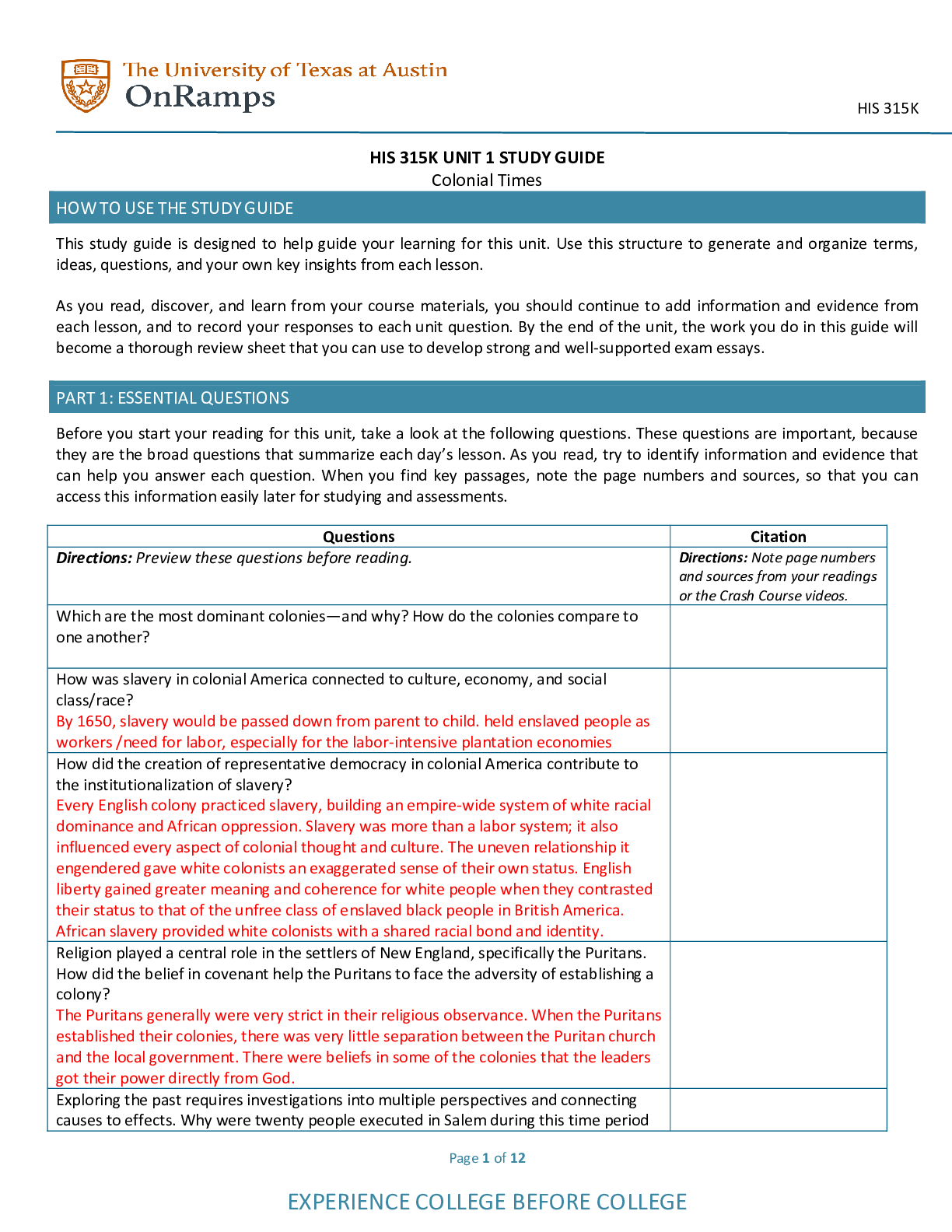
.png)

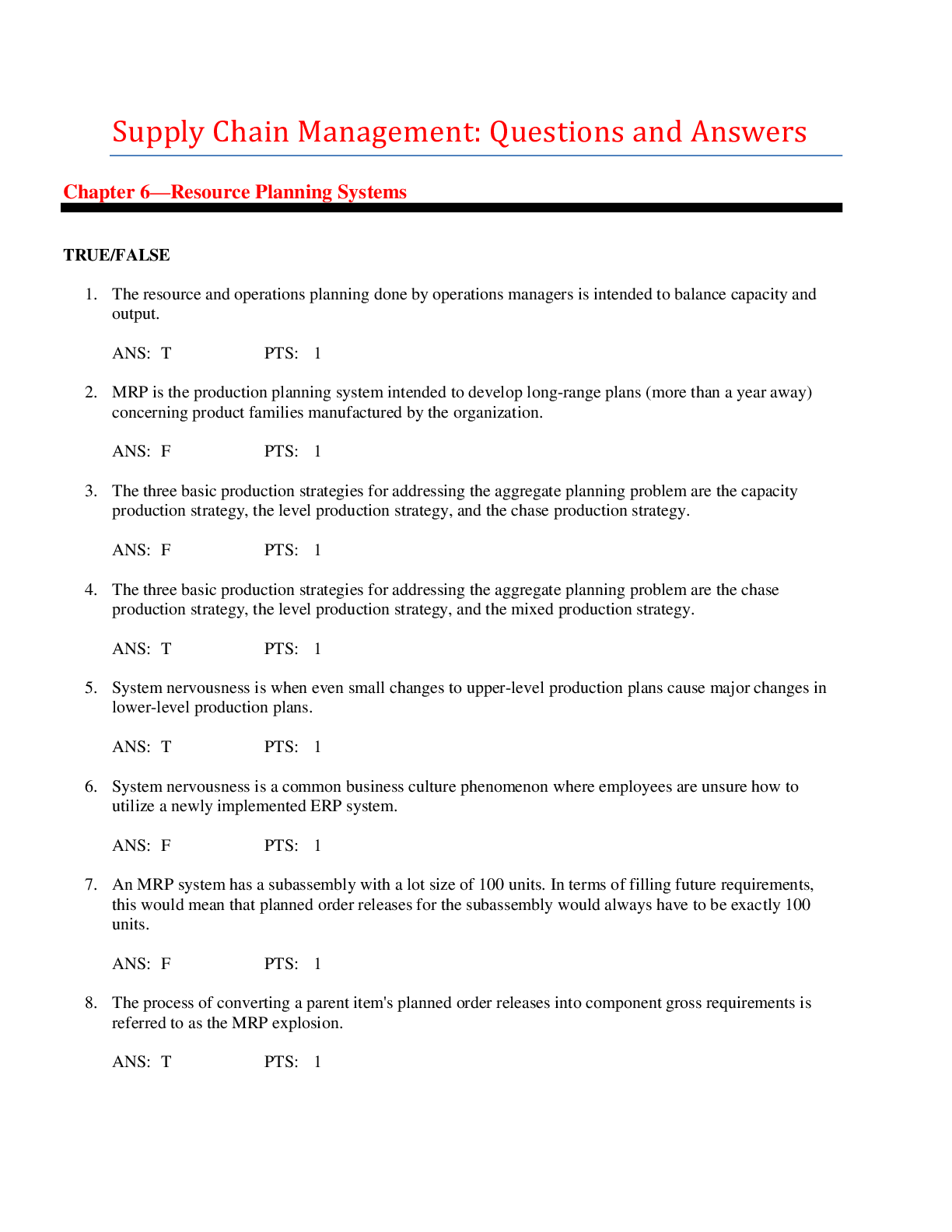
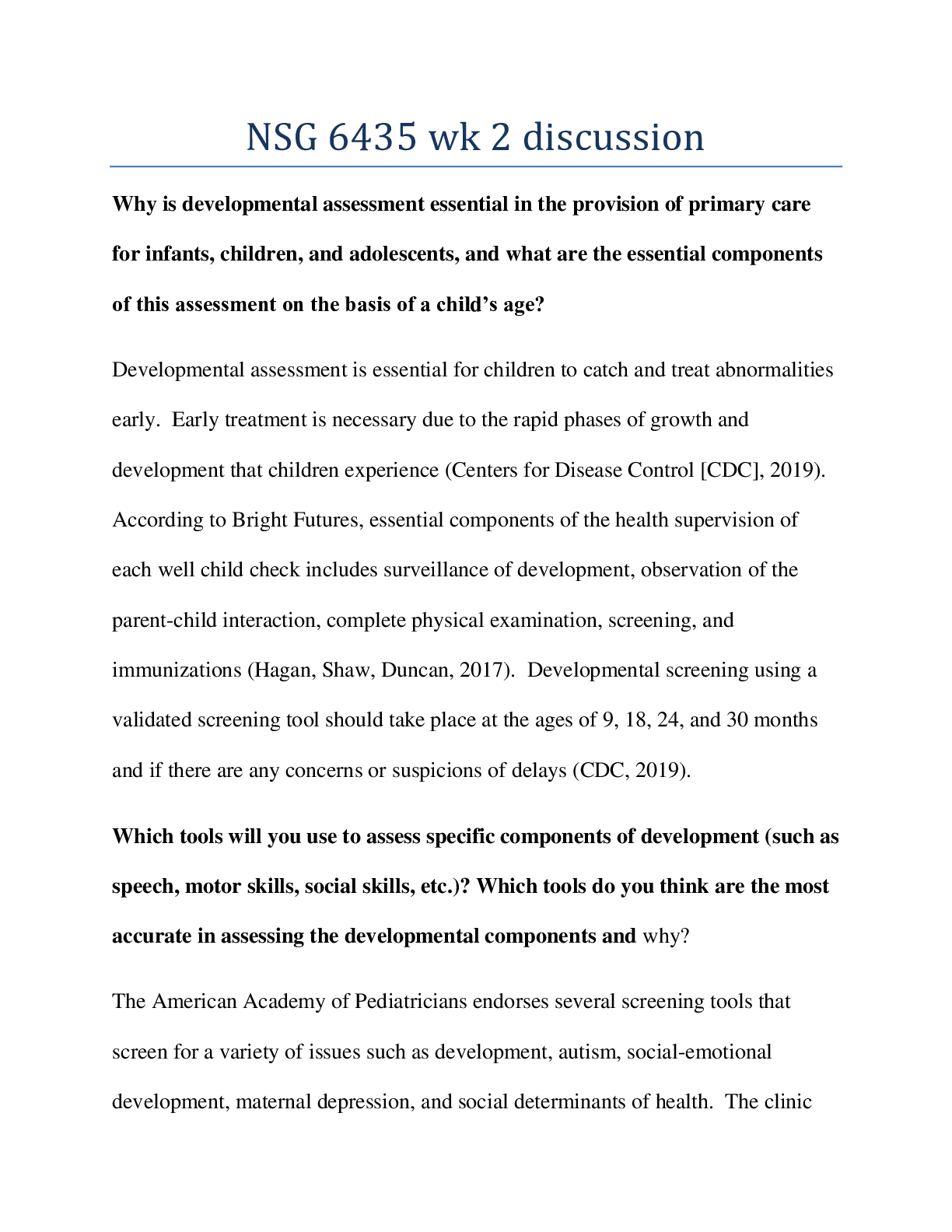
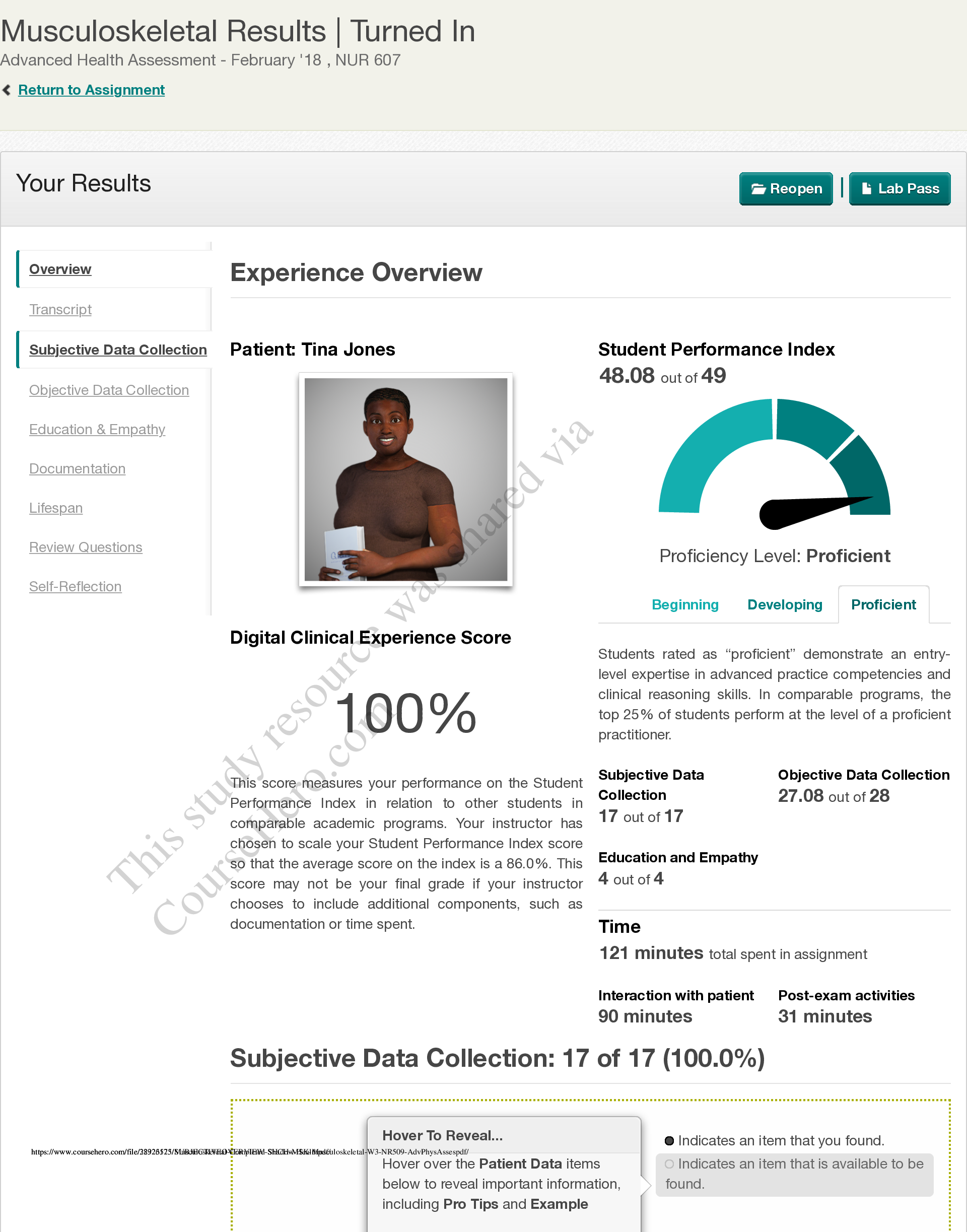
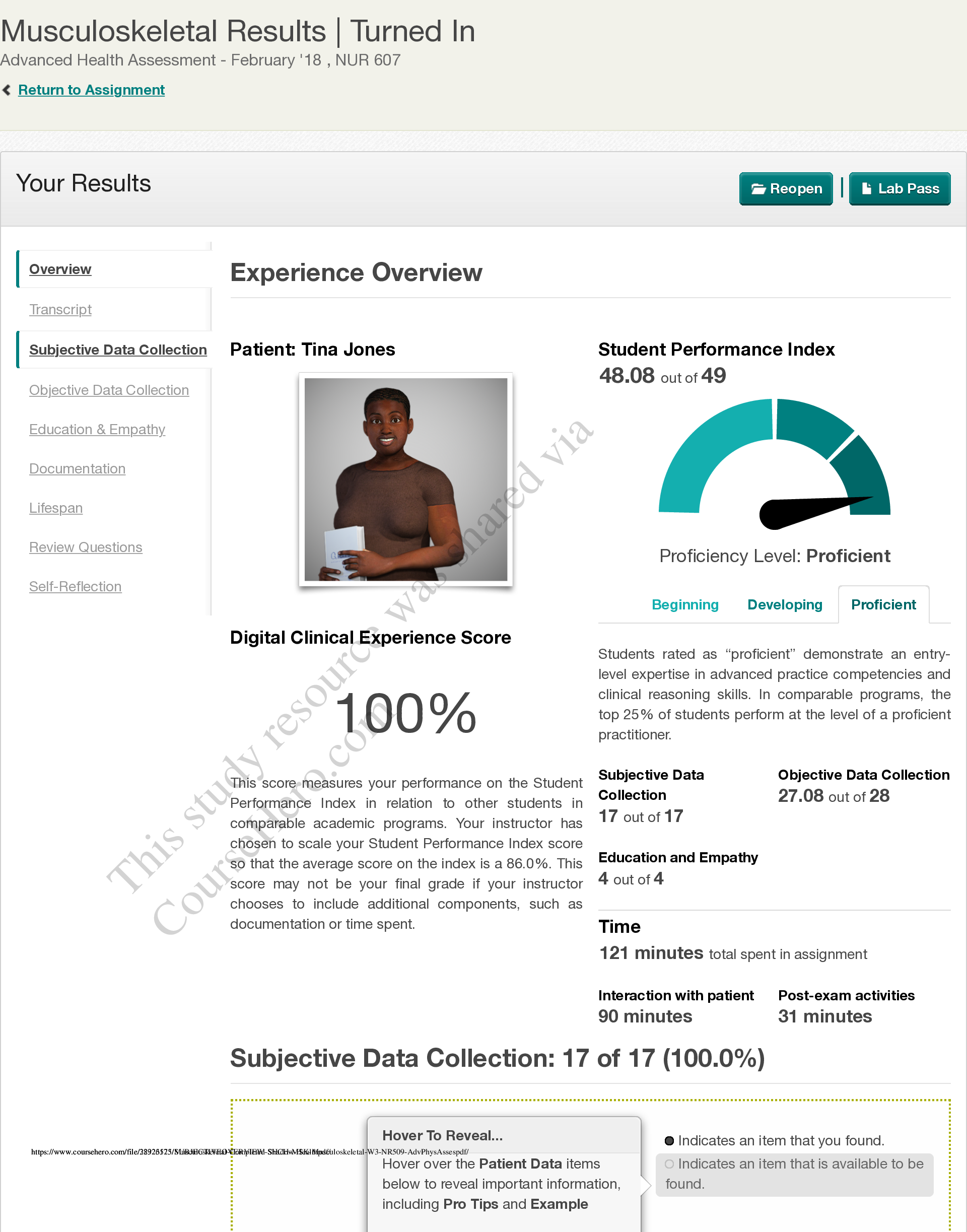
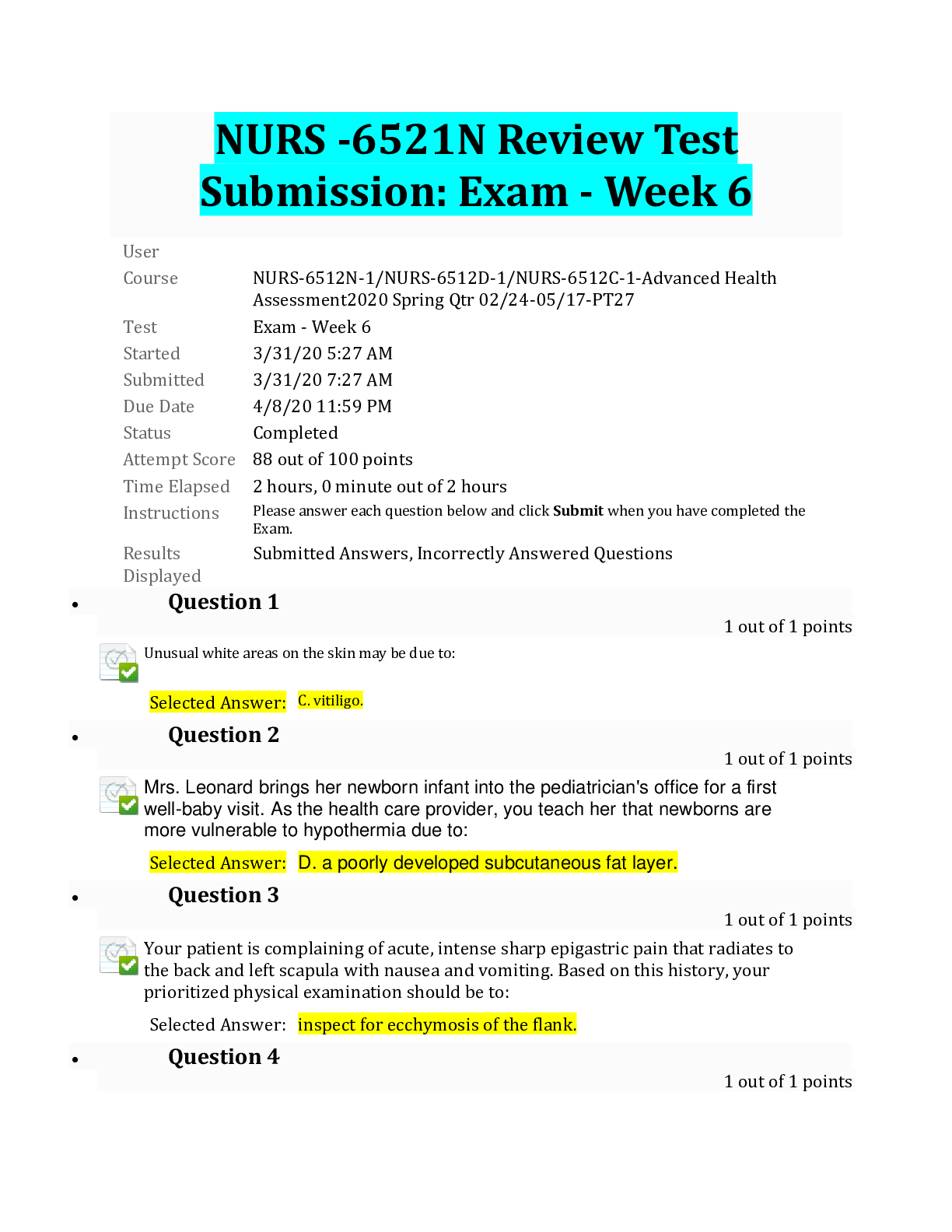
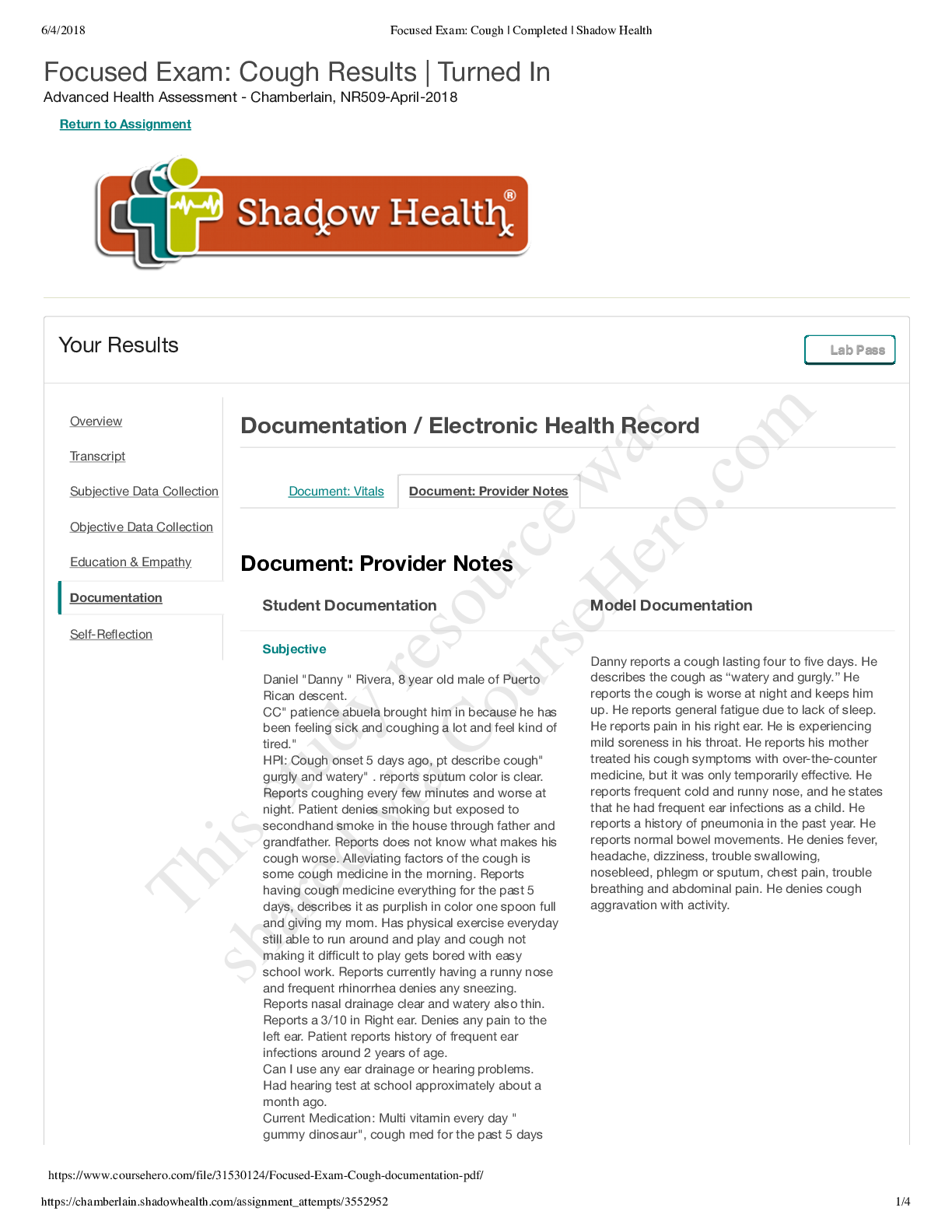
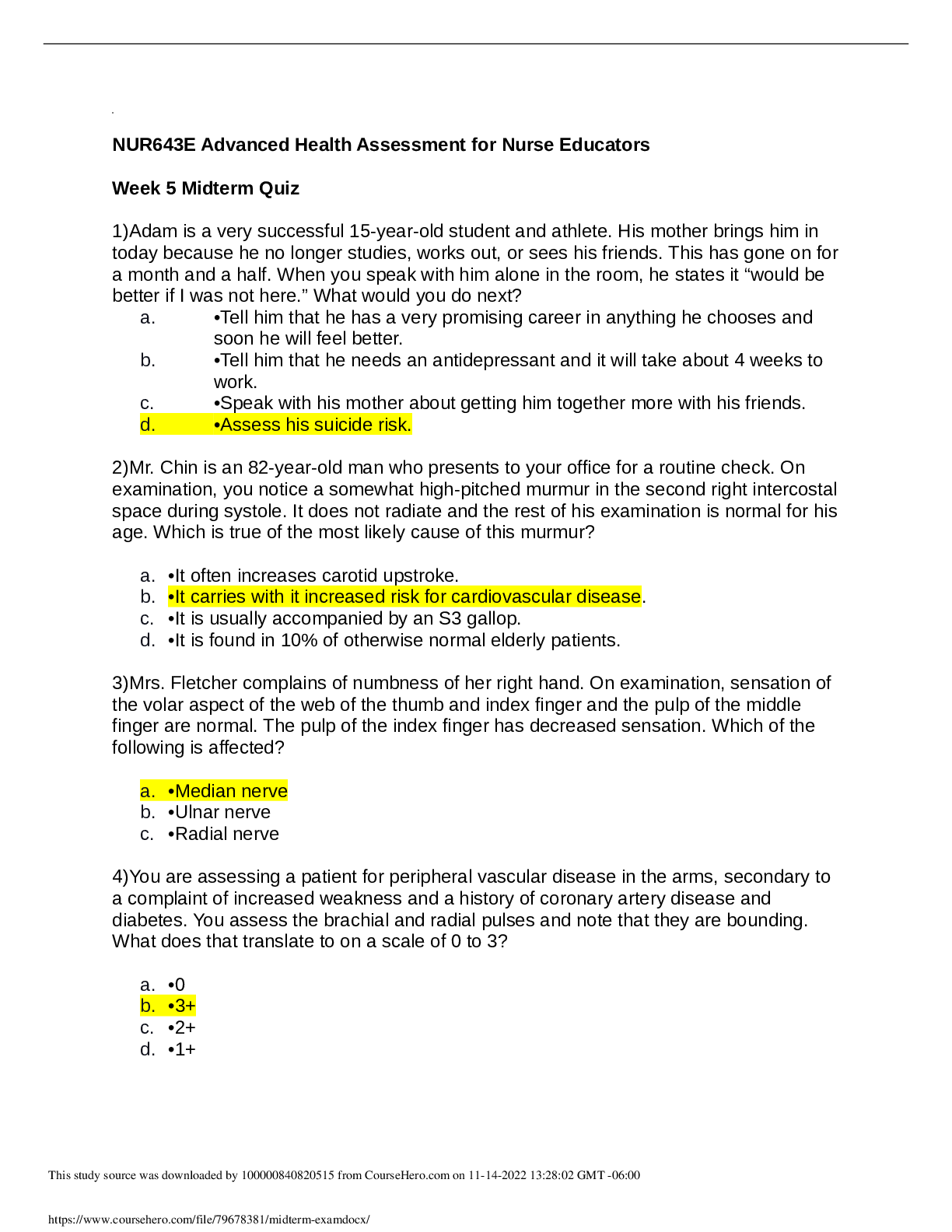
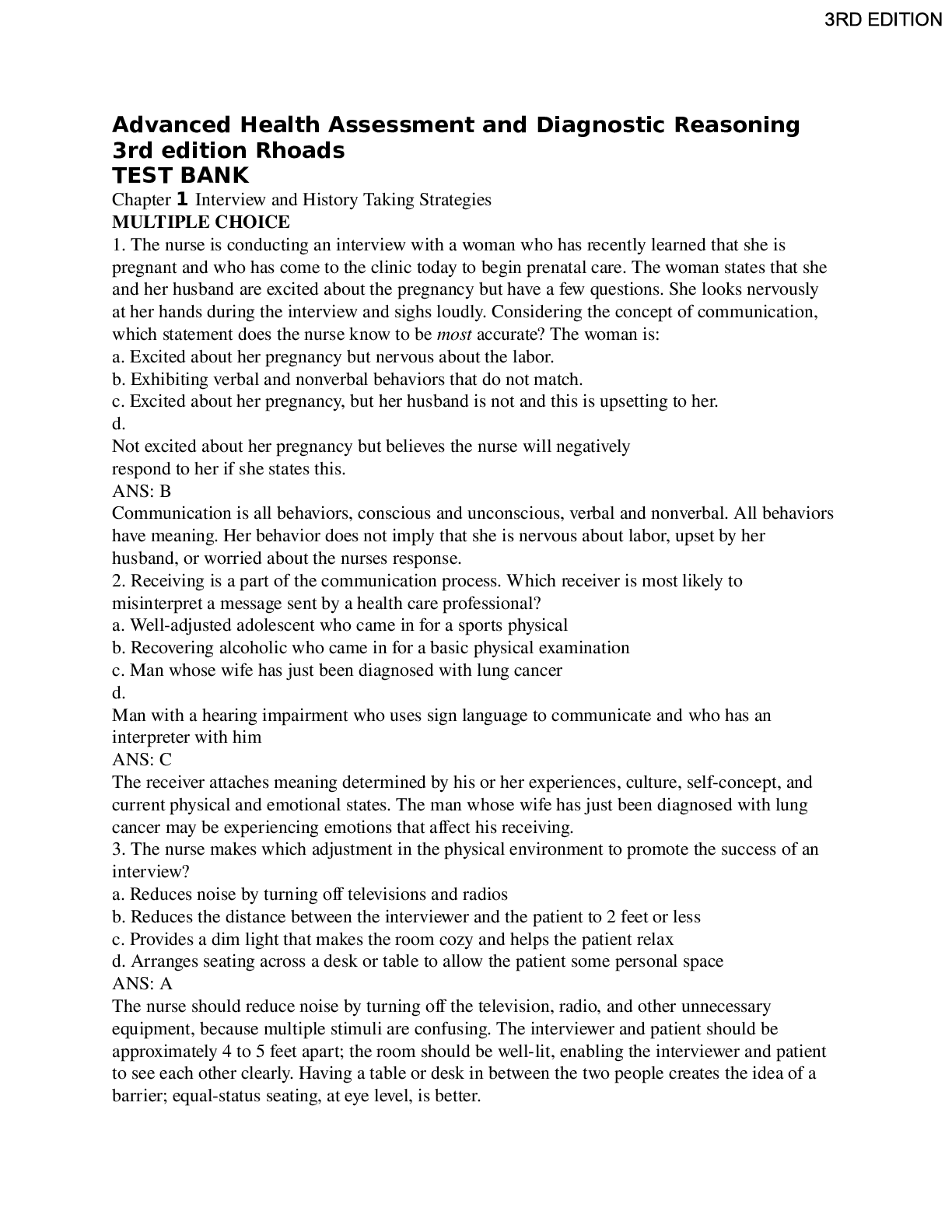
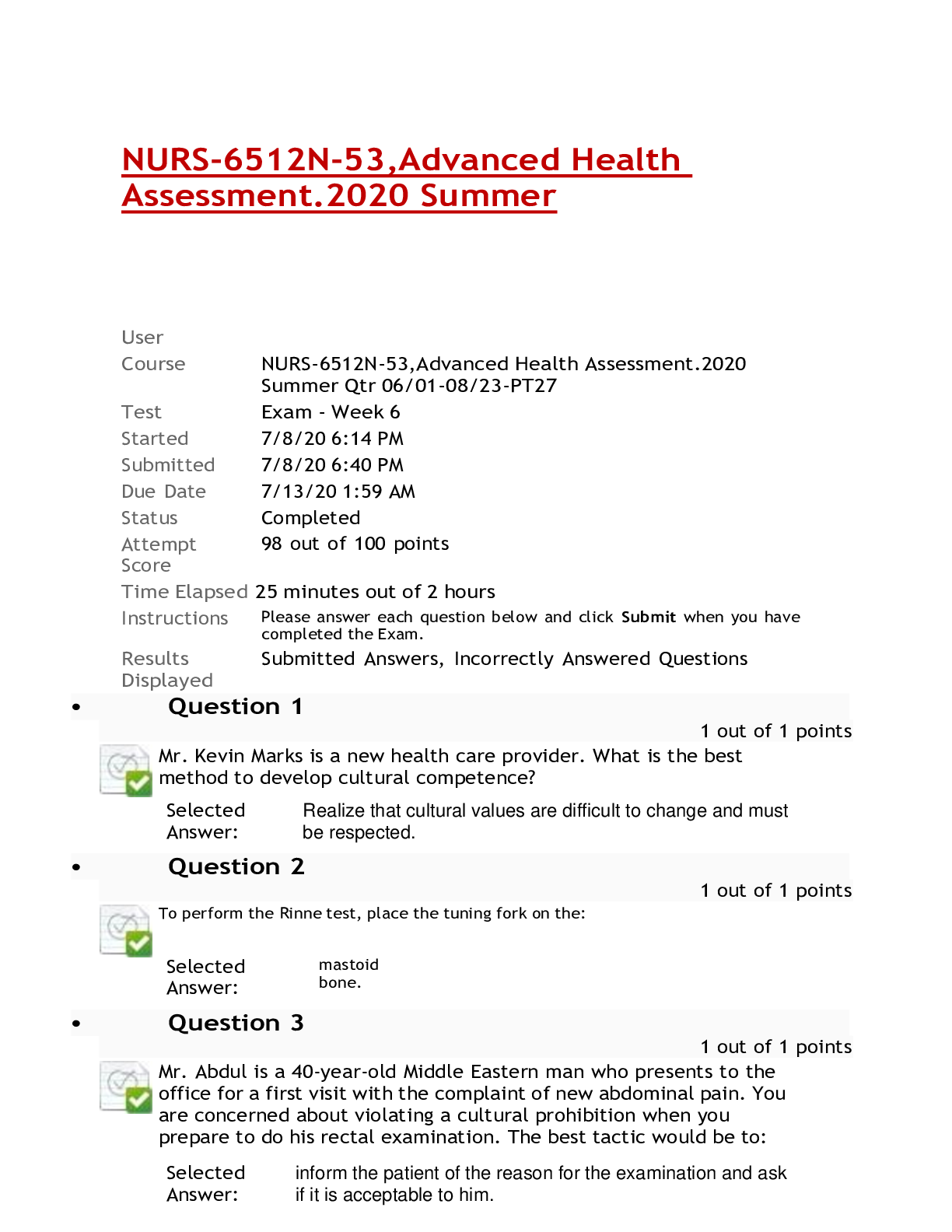
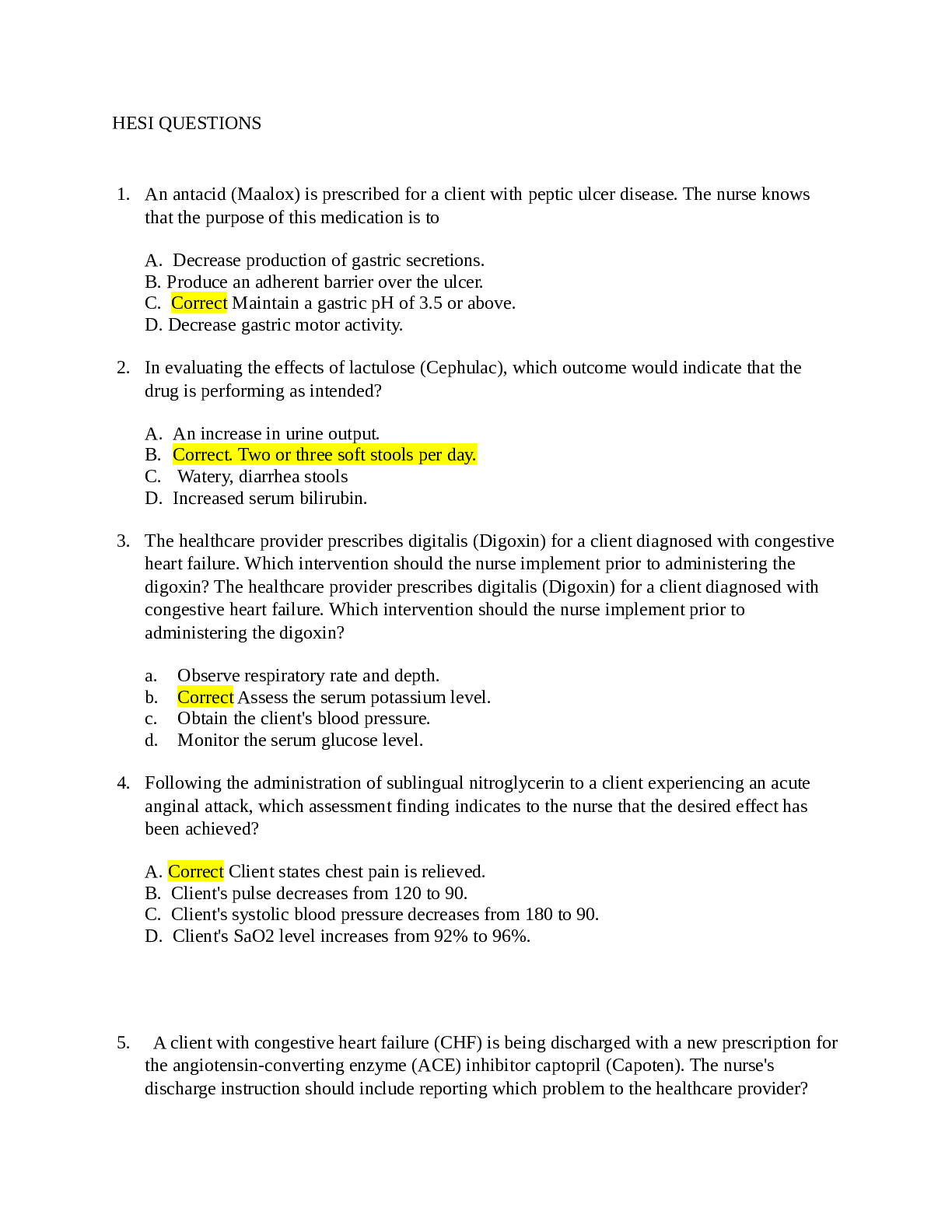

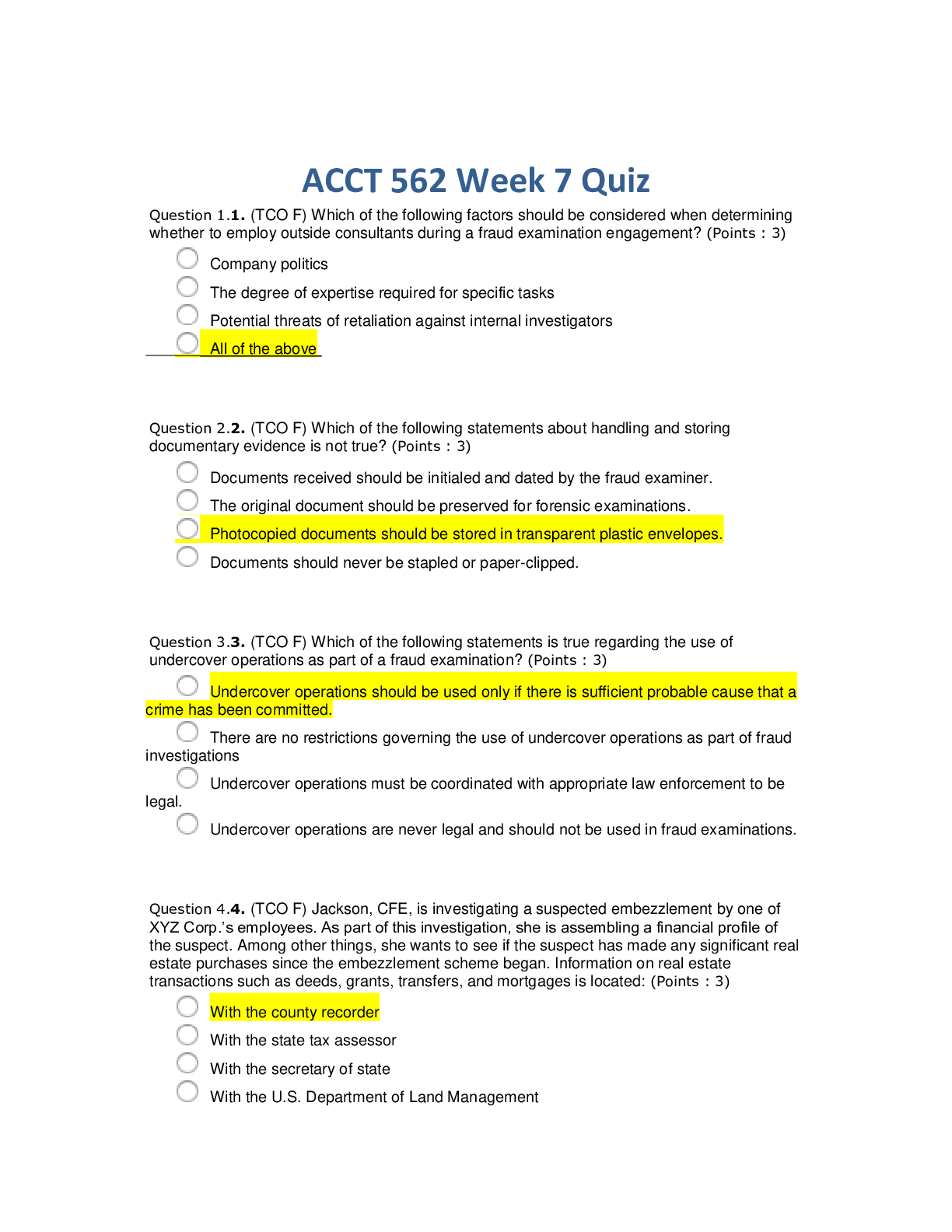
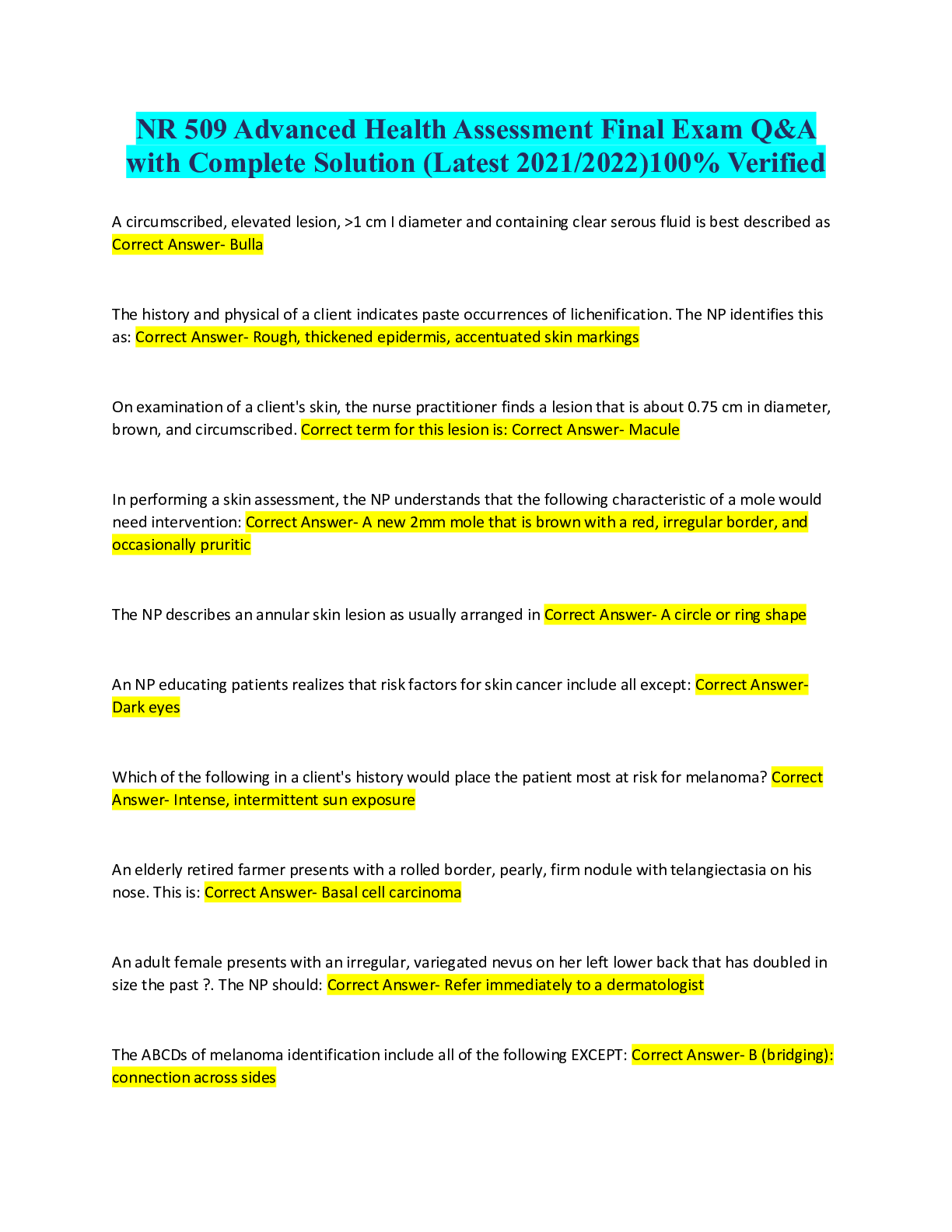
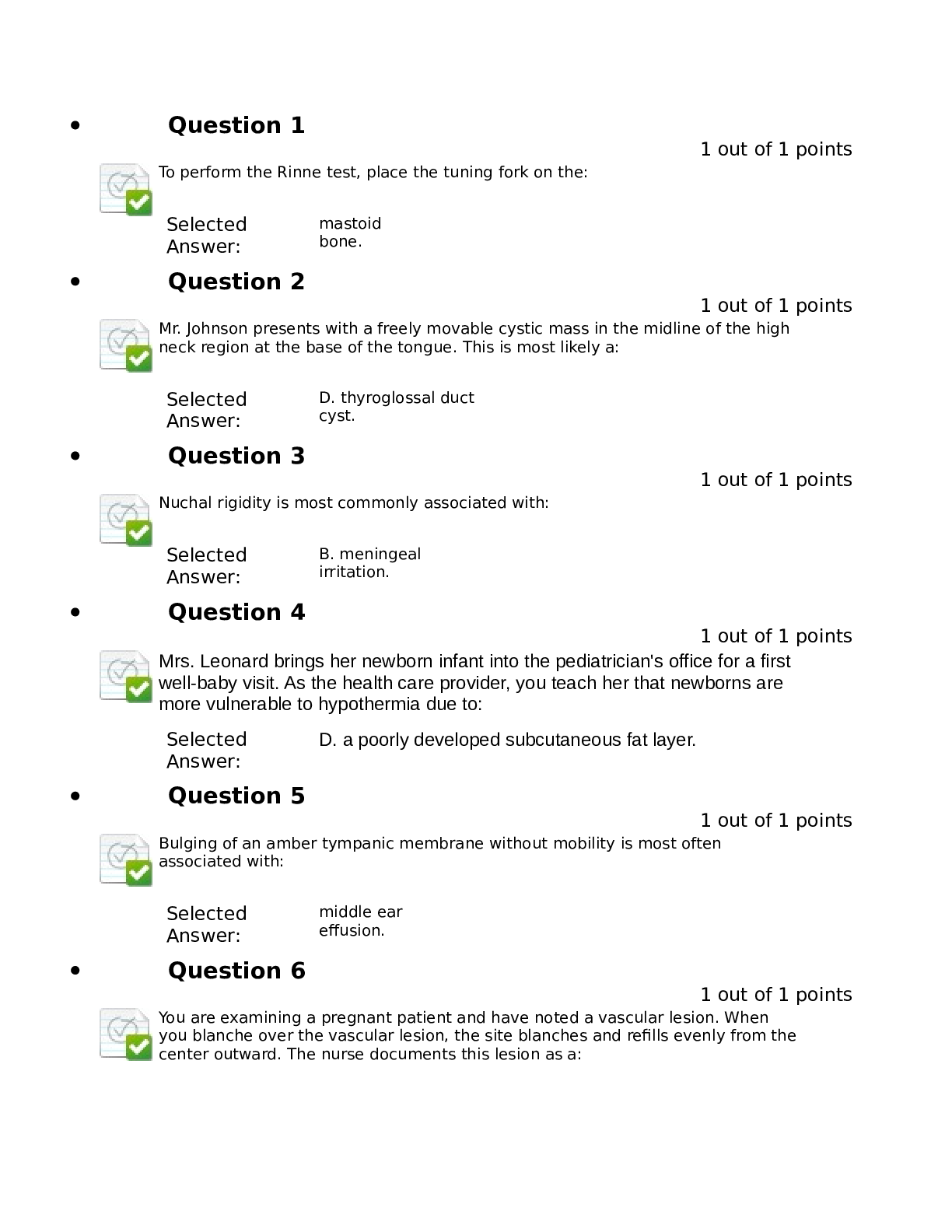
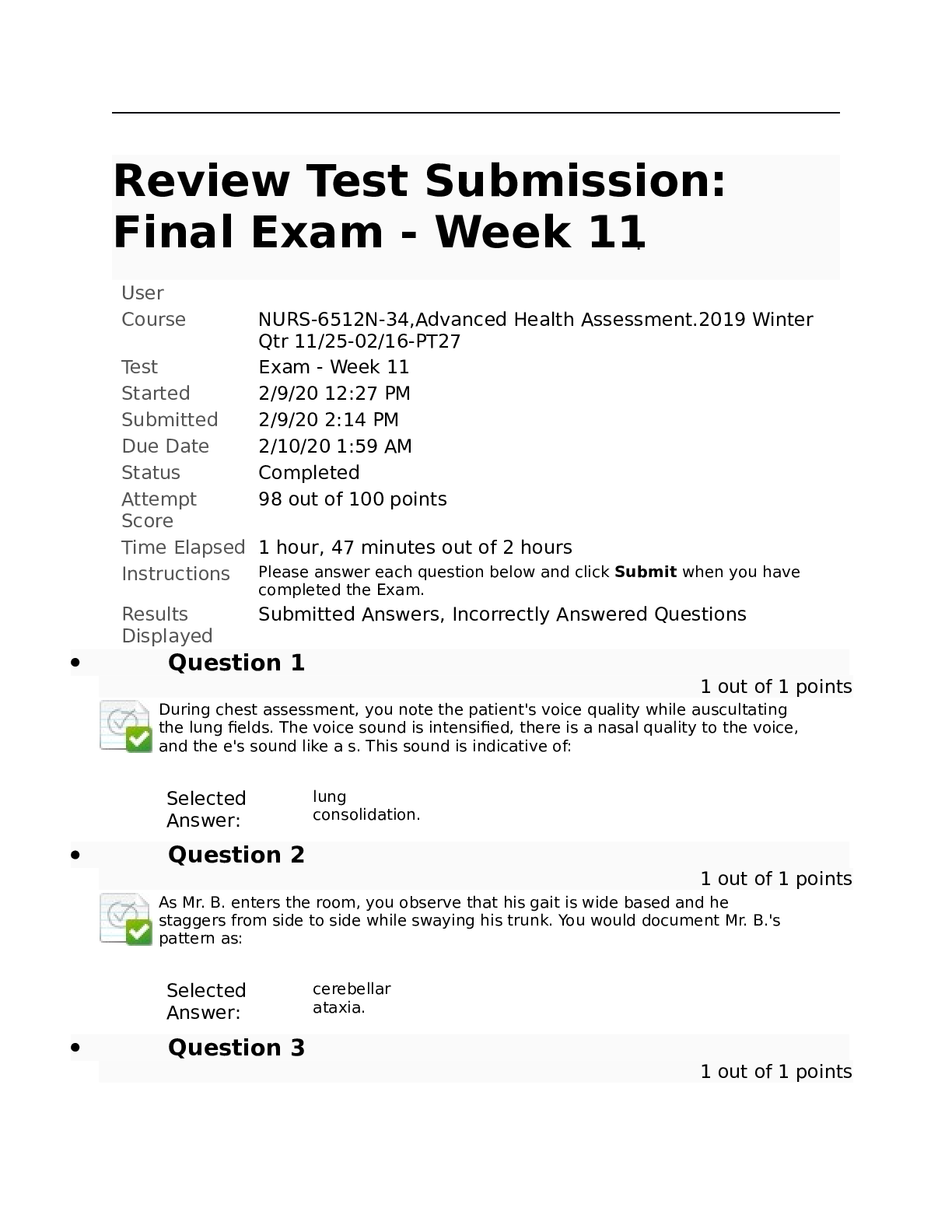
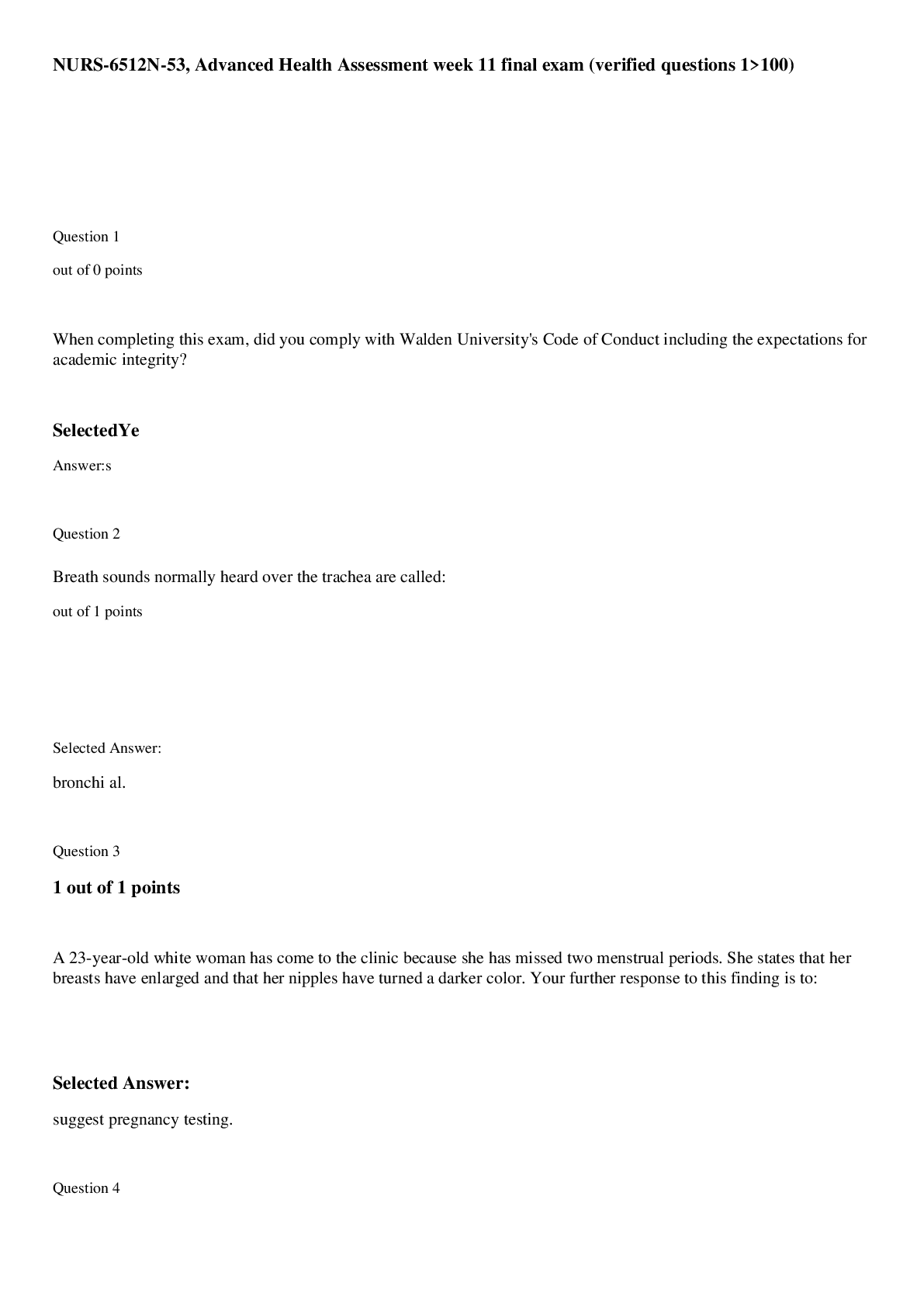
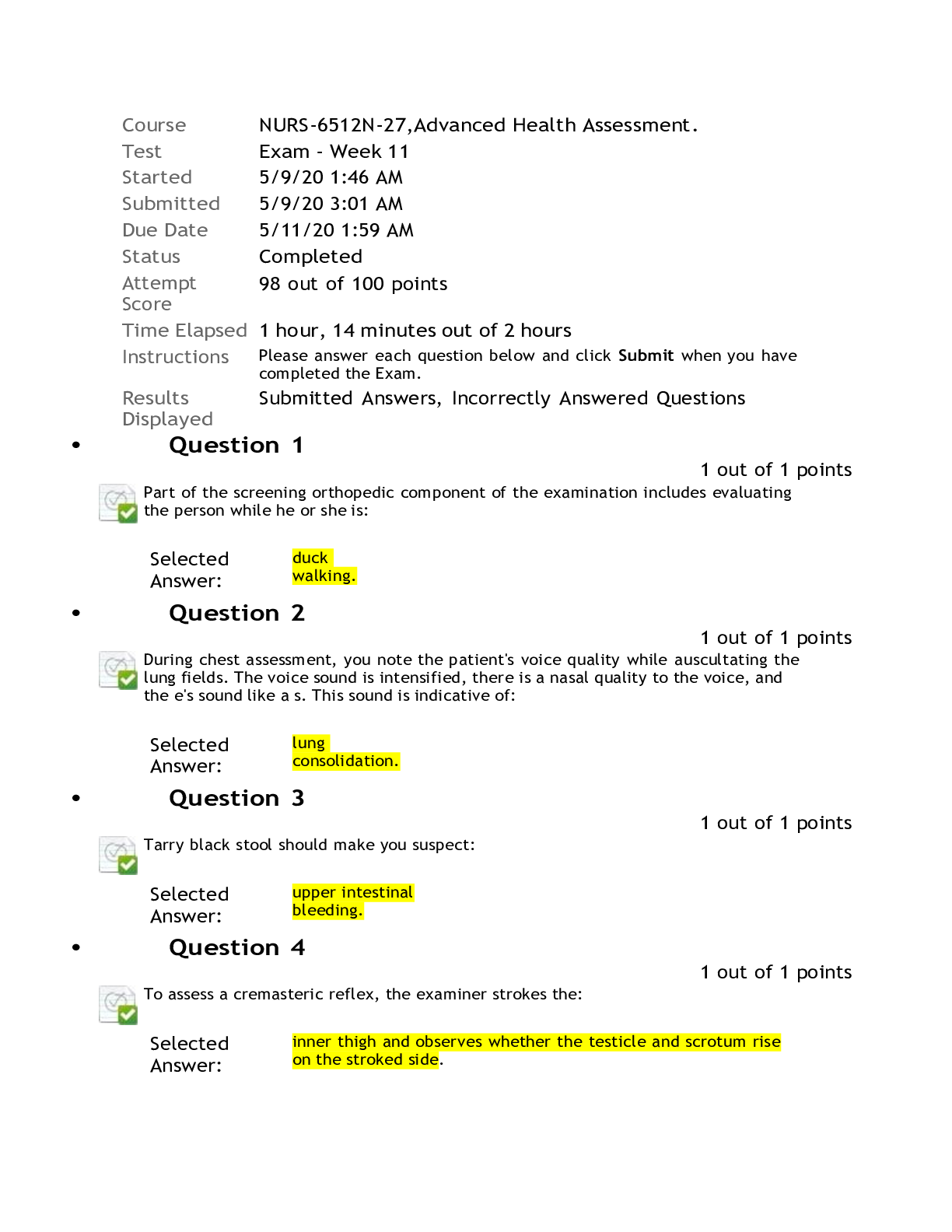
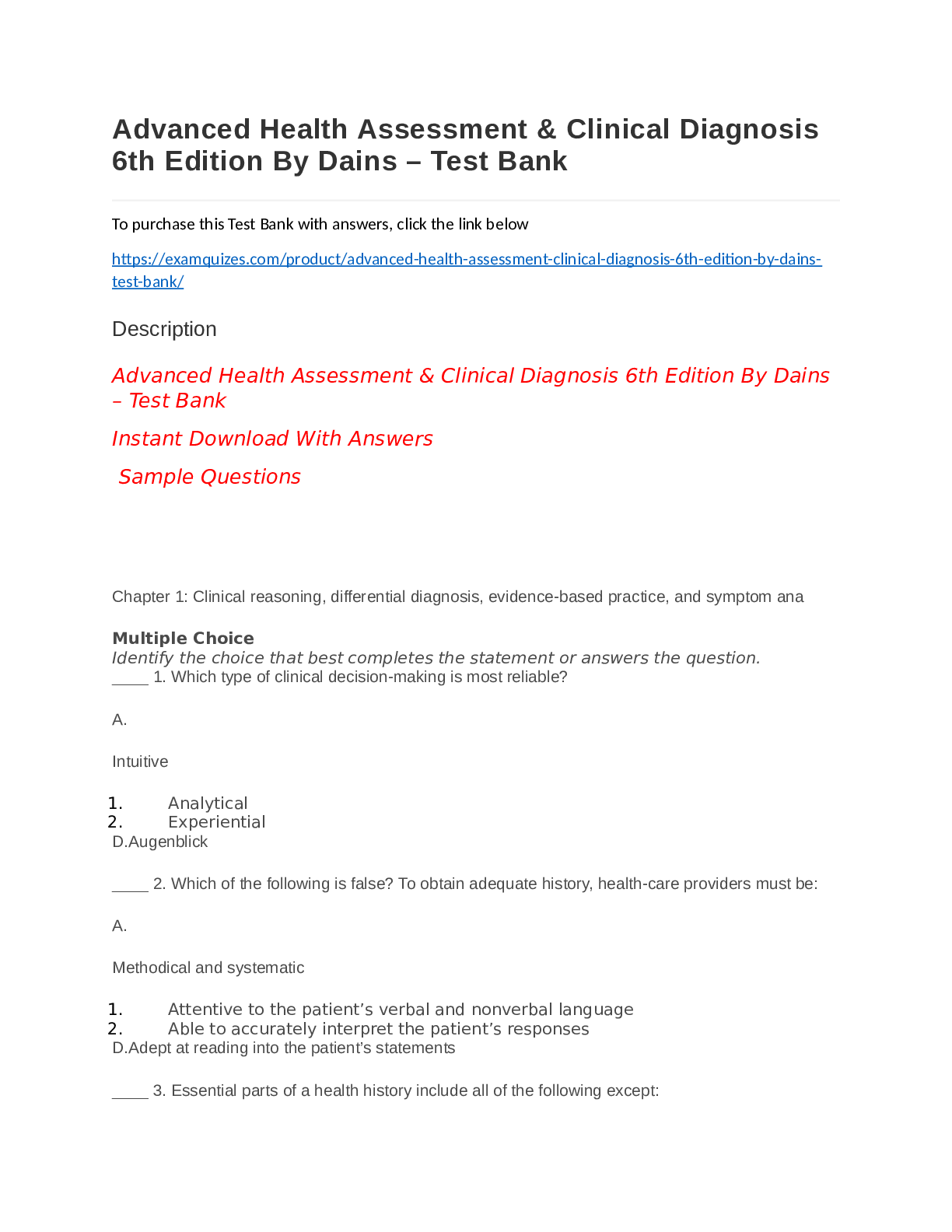
 (1).png)

